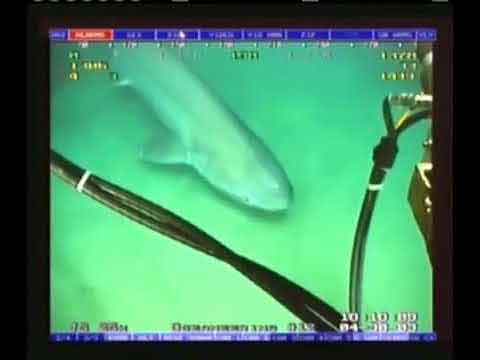Loading…
How The Internet Works
How the Internet works is fascinating. It is available to over 228 countries connected by a series of wires or cables, and other technology that provides the platform for the World Wide Web to operate.
Most of the planet make use of the Internet in one form or another, but I bet most of us don't know much about how the Internet works exactly.
I thought this article would be a good addition to the basic computer learning section. We already have articles on fibre broadband and how to search the Internet, so it makes sense to me to have a complimentary article on how the Internet works too.
In the next section, we take a look at what the Internet is. We then focus on the hardware that makes up the Internet, i.e. the wires, hardware components and servers.
We then take a brief look at what happens specifically when we access a website, just like you are doing right now.
Join The Human Byte — get the free BIOS Update A-to-Z guide
- Follow a safe, step-by-step BIOS update process
- Printable checklist + pitfalls to avoid
- Monthly email with practical PC tips.
- I only use your e-mail for the newsletter. Unsubscribe anytime.
Contents
What Is The Internet?
The Oxford Dictionary defines the Internet as:-
"A global computer network providing a variety of information and communication facilities, consisting of interconnected networks using standardized communications protocols"
The dictionary definition is quite a mouthful, so let's break it down and look at each part of the definition in a little detail.
A network (or Internetwork) is a means of connecting computers together. This is achieved using different types of wires running all over the world (global), and more lately, through satellites and mobile (phone) networks.
Have you heard of terms such as IP addresses or Hypertext Transfer Protocol (the http or https bit you sometimes see in your web browser)? Well, these are just two of the many types of standardized communications protocols the definition refers to.
A protocol is simply a fancy term that describes or encompasses the rules that are in place to ensure the Internet works properly.
There is a lot of information moving within the Internet, and just like our roads, there are a variety or rules, or protocols, in place to make sure the traffic moves freely.
A network, or different connected networks, enable computers to talk to each other (following the rules or the protocols). The rules are basically software programs and algorithms, which are all based on mathematics.
Different hardware types enables the communications over the Internet wiring. Routers and Switches are a couple of hardware devices that you may have heard of.
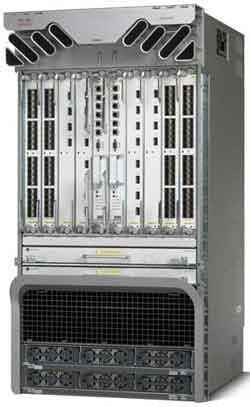 How The Internet Works
How The Internet WorksA Very Powerful Router that Your ISP
May Use to Connect You To the Internet
Source:- cisco.com
However, our computers, and other device types that we use at home, or at work, do not directly connect to the Internet. We actually access the Internet through Internet Service Providers (ISP's).
See the What is Fibre Broadband? Article that describes in a bit more detail just how we are connected to the Internet from our homes.
ISPs are connected to the Internet. Their computers are called Servers, and it is these Servers that enable us to access the World Wide Web.
The World Wide Web refers to all the information we search for and browse every day. This includes web pages such as this one, applications we download and install, gaming, books, instant messaging and cloud hosted services. This is the variety of information and communications facilities the definition above refers to.
In the next section, we take a look at the hardware that makes up the Internet and the World Wide Web in more detail.
Return to the Table of Contents
The Hardware | Wires Components and Servers
Huge amounts of cables are running all over the work that make up the backbone of the Internet. Some of these cables are thousands of miles long, and run across oceans on the seabed.
These huge cables are implemented and supported by various large cabling companies, and often have the cables named after them.
For example, the company GTT support the GTT Atlantic cable, which connects the UK, Ireland, Canada and the USA together. The cable length is a huge 12, 200 kilometres in length, and it is not the longest cable that makes up the Internet either.
As you can see from the image below, there are lots of cables running between Continents and Countries. There are so many to cope with the demand as our Internet usage increases, and they provide a level of resilience and redundancy, just in case there is a major fault with one of the cables.
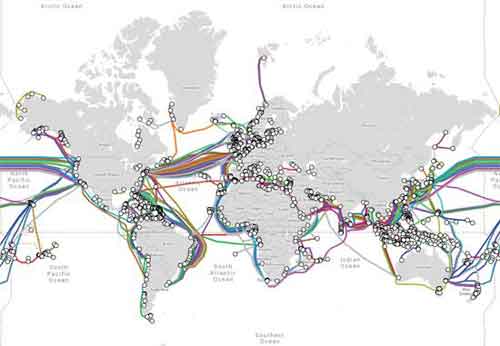 How The Internet Works
How The Internet WorksMap of Worldwide Internet Cables
Source:- submarinecablemap.com
There is every chance some of your Internet traffic has travelled across cables such as the GTT Atlantic, and if you think about the volume of people using the Internet, it will come as no surprise that these cables need to be extremely robust.
Firstly, they need to survive at the bottom of the ocean for years with minimal numbers of faults. You can't just replace a cable like this if it is faulty or damaged. It involves boats, submarines and robots to fix. A lot of redundancy will be built in to these cables so if there is a minor fault it won't adversely affect us.
Secondly, their performance must meet certain standards otherwise we will notice some of our services slowing down, or not working consistently, or even at all.
The TAT-14 transatlantic cabling system, which is 15, 285 Km in length connecting Europe to America, operates at 3.2 TB/s (put your 40Mb/s home broadband connection to shame!), but has the capacity to operate at 9.38 TB/s. Now that is fast, but there are other cables that can operate at 250 TB/s, such as the Dunant cable that connects France and the USA together. This cable is owned by Google.
These cables are made up of what is known as fibre pairs, and fibre uses light to send us our data, such as our Internet search results or downloads. This is why it is so fast, and is why a request from the UK to a data source in the USA, e.g. a web page, can be fetched (displayed on your screen) in milliseconds. It is quite mind-boggling when you think about it.
The image below is of a typical Internet backbone cable. It is huge and looks quite different from the types of Internet cables we use.
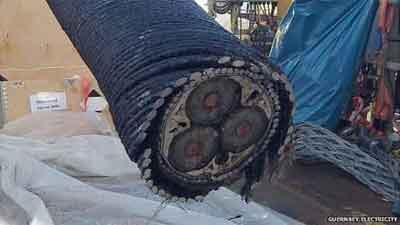 How The Internet Works
How The Internet WorksInside An Internet Cable
Source:- extremetech.com
Thirdly, there is the security to consider. These cables need to be durable to survive in the ocean, and to survive any form of attack.
I found the video below absolutely fascinating. It shows a shark at the bottom of the ocean, biting one of these Internet cables. This is the sort of attack the metal cover on the outside of the cable is designed to protect against.
Thankfully, this shark didn't suffer the same fate as Jaws when he bit down on a cable. All I can say is thank goodness for Martin Brody (Roy Schneider).
How The Internet Works
Video of Shark Biting an Internet Cable
Internet Service Providers connect different types of networking equipment to the Internet backbone. This equipment includes hardware such as routers and firewalls.
Each component is important to the functioning of the Internet. Firewalls provide a layer of cybersecurity protection against all the nefarious activity on the net. Routers, as the name suggests, routes our data within and between the different networks that make up the Internet.
ISP's and other hosting providers have Servers connected to their network equipment. It is these Servers that host the data, such as websites like ecomputerz.com. The image below is typical of what modern Internet servers look like.
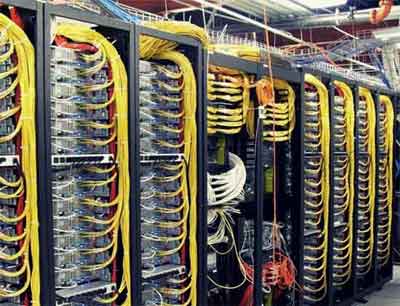 How The Internet Works
How The Internet WorksTypical Internet Servers
Source:- pinterest.co.uk/dpaircorp/
Finally, it is worth touching on something called packet switching. This is basically the way information moves over the internet. This is the fundamentals of how the Internet works.
Suppose you are sending an a-mail to someone over the other side of the world, and your e-mail has some photographs attached. When you hit the send button, the information you have typed up, and the attached photographs, are split up into little 'parcels' called Protocol Data Units (PDU's).
PDU's are frequently referred to as packets, and sometimes by other names, such as segments or frames. Don't worry about this. For the purposes of a basic computing article, they all mean and refer to the same little parcels of data mentioned above.
Each PDU is tagged so when they reach their destination on the other side of the world, they can be reassembled in the right order, and can then be opened and read by the recipient.
Each of the parcels or PDU's could take different routes over the Internet backbone, and it is this packet switching approach that gives the Internet its efficiency and performance.
In the next section, we take a look at what happens when you use the Internet and specifically, what happens when we load up a website in our web browser.
Return to the Table of Contents
The Software | What Happens When You Use The Internet
The data we access or consume every day is what makes up the World Wide Web, and the Internet is what enables the web to work.
A lot of our web use is by accessing websites, just like you have done here. So, what happens exactly when you click the link from your search, or hit return after typing in the website's web address? The image below illustrates what happens quite succinctly.
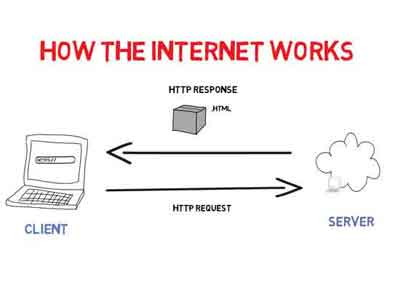 How The Internet Works
How The Internet WorksSource:- medium.com/@e_73215
Step 1
The client such as your computer, laptop or tablet issues an HTTP GET request, i.e. get me that information I've just asked for.
Step 2
The request is then sent to the Server that has the data you have asked for. Something called a Domain Name Server (DNS) helps here.
DNS is one of the many protocols or rules mentioned earlier. DNS basically checks your request to access ecomputerz.com and makes sure it exists, before sending the request to the IP address associated with the website.
Step 3
When the Server that is hosting the website receives the request, it sends the information back to you (the client) with an HTTP response message, i.e. here is the information you asked for.
Step 4
When your computer receives the information with the response message, it converts the computer data in to something that is understandable to you, i.e. the web page you see before you.
The data that you ask for, and is subsequently received, can be sent and received in lots of PDU's that take different routes between your client and the web server, i.e. using packet switching methods.
There are billions of requests such as this happening every day, and the volume is set to increase over the coming years.
Return to the Table of Contents
How The Internet Works | Final Thoughts
The Internet is a series of interconnected wires and hardware components that enables us to create and access information, or data, on the World Wide Web.
How the Internet works is fascinating, and remarkable. I think it is an important part of everyone's understanding of basic computing. Before you drive a car, you need to understand how it works to some degree, and what to do if something goes wrong. Computing is exactly the same.
To support the computer help provided in this article, take a moment to watch the video below. It is an excellent tutorial on how the Internet works.
How The Internet Works Video
The djangogirls website compliments the video above, and the Submarine Cable Map is the interactive underwater cable map referenced in the video and article.
